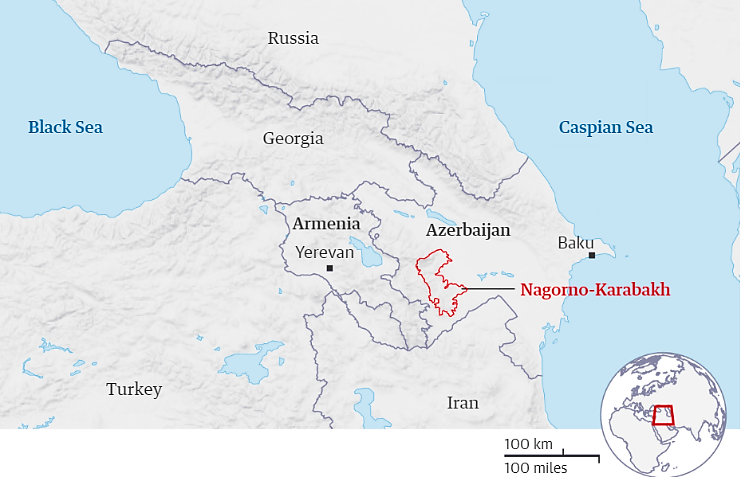What is happening?
- Recently, Armenia announced it was declaring martial law, mobilising its army and ordering civilians to shelter.
- It claimed its neighbour Azerbaijan had launched a military operation inside a disputed region called Nagorno-Karabakh. Azerbaijan said it attacked only in response to Armenian shelling.
- Nagorno-Karabakh is recognised internationally as Azerbaijan’s territory but has a mostly Armenian population who have resisted Azerbaijani rule for more than a century.
- In 1991 the region declared independence and since then it has ruled itself – with Armenian support – as the unrecognised Republic of Artsakh.
- Recently, Forces from Nagorno-Karabakh along with the Armenian military have been fighting Azerbaijani troops, armour and aircraft.
- Azerbaijan has claimed to have taken territory inside Nagorno-Karabakh, a claim the Armenians dispute.
What’s the background?
- Nagorno-Karabakh, a mountainous, landlocked region inside the borders of Azerbaijan, has been a source of dispute since before the creation of the Soviet Union.
- Tensions were suppressed when both Armenia and Azerbaijan were Soviet states, but they re-emerged as the cold war ended and Communist party control of the bloc dissolved.
- A war between Armenian and Azerbaijani forces ended in a ceasefire in 1994, with Armenia in full control of Nagorno-Karabakh and other smaller enclaves of Azerbaijan’s territory.
- Azerbaijan is majority Muslim and Armenia is majority Christian.
Why are they fighting now?
- An Armenian revolution in 2016 ushered in a new generation of leadership and raised hopes that the Nagorno-Karabakh conflict could move towards resolution.
- Those aspirations have since dwindled, with Armenia’s prime minister, Nikol Pashinyan, taking a firm line on the issue similar to his predecessor’s.
- With the Covid-19 pandemic taking a toll on the price of Azerbaijani oil and gas, it may be that its rulers have decided now is a good time to act.
- Turkey has already declared its staunch support for Azerbaijan, while Russia is traditionally closer to Armenia, though its ties with Azerbaijani elites have grown.
- The two countries have been jostling for influence in different theatres around the world including in Syria and Libya.
- Armenia has claimed that Turkey is sending Syrian fighters into the area to fight on Azerbaijan’s side, though there is not yet strong evidence for this.
- The wider South Caucasus is a crucial artery for gas and oil from Azerbaijan into Turkey and on to Europe and other world markets.
- Azerbaijan supplies about 5% of Europe’s gas and oil demands (helping to reduce the EU’s dependence on Russia), and fighting in 2016 came close to a number of these pipelines.
